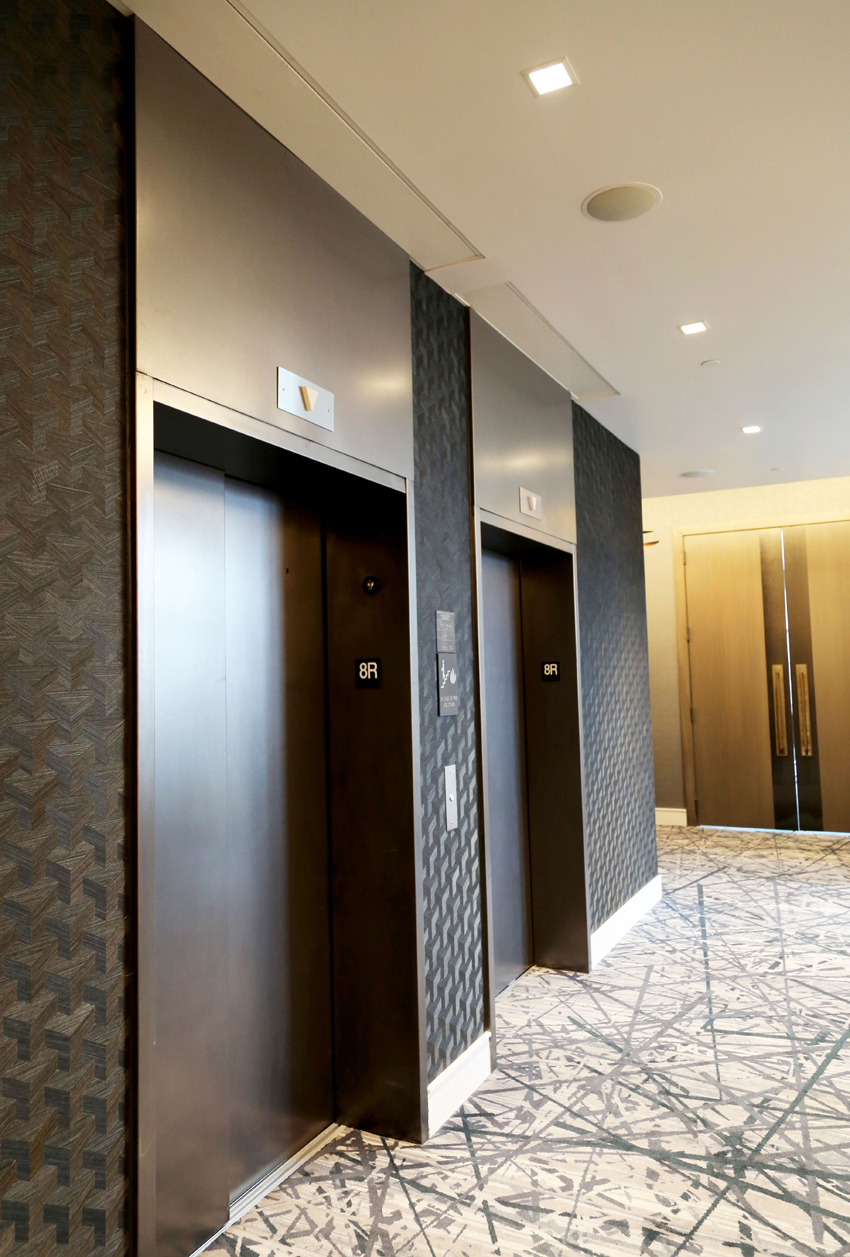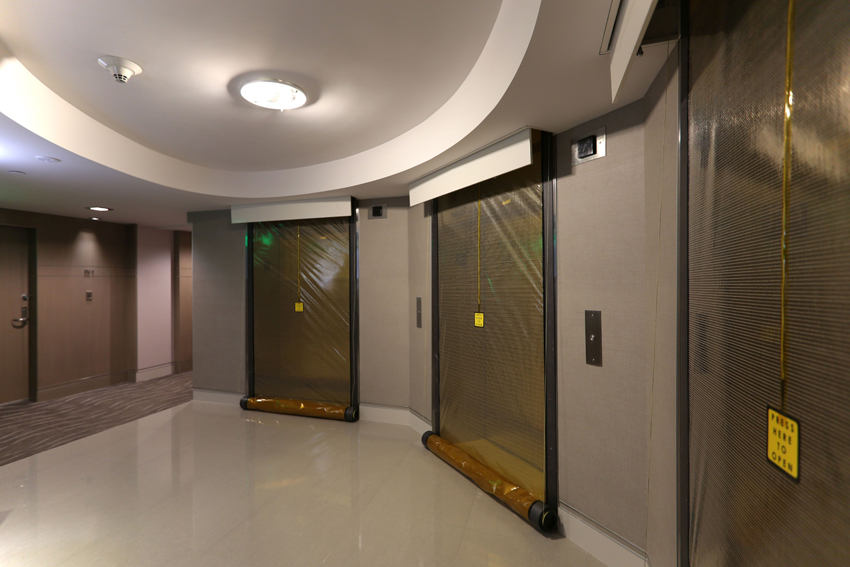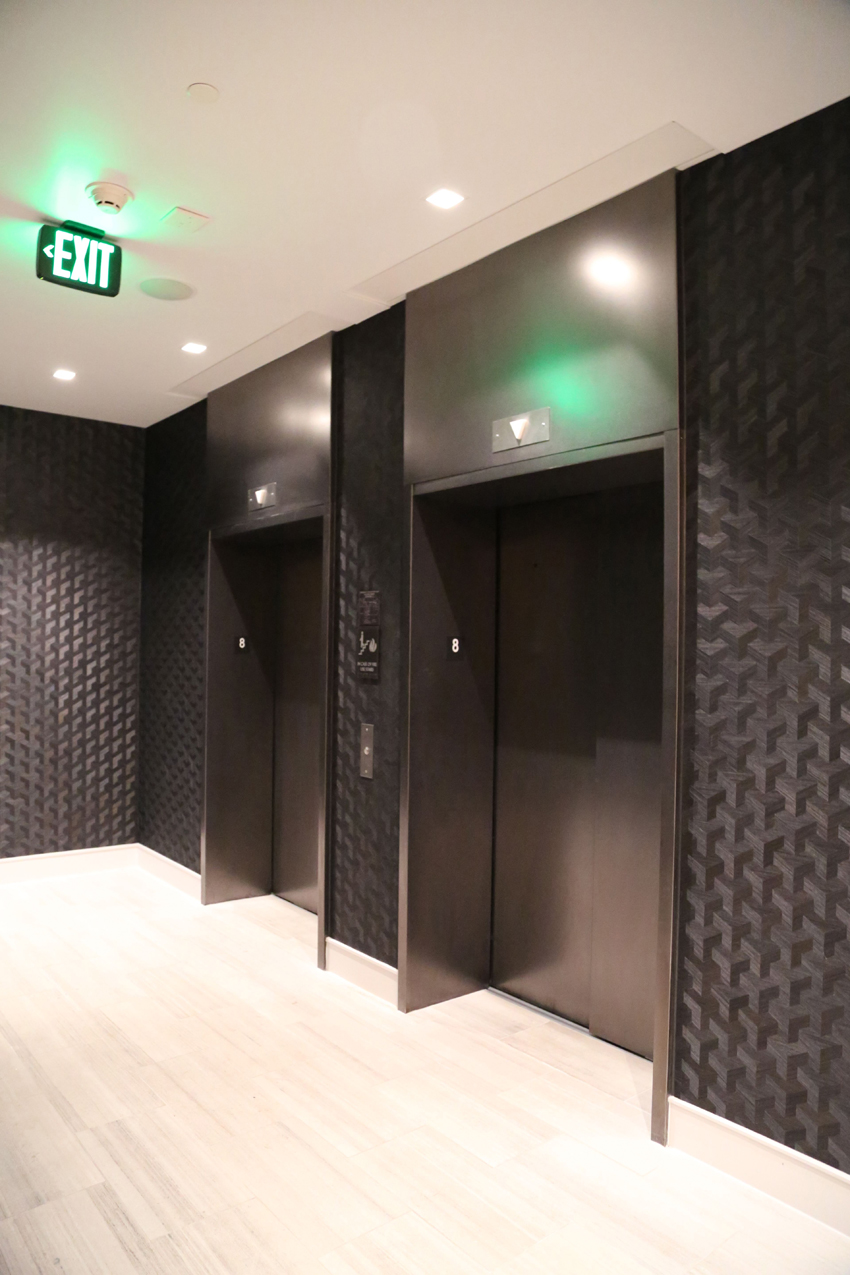Deployable Fire- and Smoke-Protection Solutions

Elevator shafts can act like chimneys in multistory buildings, and smoke migration must be contained in the design.
In elevator hoistways, smoke migration can be far more dramatic and deadly. Elevator shafts act like chimneys in multistory buildings, enabling large quantities of air to move from floor to floor. When a fire occurs, the shaft serves as a conduit, transporting smoke throughout a building. The heated smoke enters the elevator shaft from the fire floor and rises, displacing the resident cooler, denser air. Stack-effect pressures in the elevator hoistway draw this cool smoke up through the vertical shaft. As the smoke rises, it easily leaks back through the elevator doors and onto other floors, exposing occupants on upper floors to this dangerous and toxic hazard. For this reason, building codes have special smoke-containment equipment that must be incorporated into areas like elevator hoistways, open stairs, and multistory spaces to prevent the dangerous vertical migration of smoke.
2018 International Building Code (IBC 2018)
The fire- and smoke-related provisions in the IBC have remained fairly consistent over the past 20 years. In IBC 2015, there was a significant reorganization and clarification of the requirements for the elevator hoistway. Now, the requirements that regulate vertical and horizontal transportation and the material-handing systems installed in buildings is found in Chapter 30, moved from Chapter 7, where they were previously located. This chapter also provides regulations for several elements that must be present to protect occupants and assist emergency responders during fires. In IBC 2018, the most recent iteration, Section 3006 specifically details the opening protection required at elevator hoistways and rated corridors. It is important to note that there are other reasons that an elevator may require smoke protection. If, for example, a corridor is required to be fire rated by the IBC's Chapter 10: Means of Egress, then an elevator opening into that corridor is required to be smoke rated. In addition, if an occupancy is required to have smoke compartments and an elevator opens into that smoke compartment, then the elevator must offer smoke protection.
Section 3006.2: Hoistway Opening Protection Required
This section of the code states, “Elevator hoistway door openings shall be protected in accordance with Section 3006.3. Where an elevator hoistway connects more than three stories, it is required to be enclosed within a shaft enclosure in accordance with Section 712.1.1 and any of the following conditions apply:
- The building is not protected throughout with an automatic sprinkler system in accordance with Section 903.3.1.1 or 903.3.1.2.
- The building contains a Group I-1, Condition 2 occupancy.
- The building contains a Group I-2 occupancy.
- The building contains a Group I-3 occupancy.
- The building is a high-rise, and the elevator hoistway is more than 75 feet in height. The height of the hoistway shall be measured from the lowest floor to the highest floor of the floors served by the hoistway.”
Section 3006.2.1 Rated Corridors
This section of the code states, "Where corridors are required to be fire-resistance rated in accordance with Section 1020.1, elevator hoistway openings shall be protected in accordance with Section 3006.3."
Section 3006.3: Hoistway Opening Protection
This section of the code states, “Where Section 3006.2 requires protection of the elevator hoistway door opening, the protection shall be provided by one of the following:
- An enclosed elevator lobby shall be provided at each floor to separate the elevator hoistway shaft enclosure doors from each floor by fire partitions in accordance with Section 708. In addition, doors protecting openings in the elevator lobby enclosure walls shall comply with Section 716.2.2.1 as required for corridor walls. Penetrations of the enclosed elevator lobby by ducts and air-transfer openings shall be protected as required for corridors in accordance with Section 717.5.4.1.
- An enclosed elevator lobby shall be provided at each floor to separate the elevator hoistway shaft enclosure doors from each floor by smoke partitions in accordance with Section 710 where the building is equipped throughout with an automatic sprinkler system installed in accordance with Section 903.3.1.1 or 903.3.1.2. In addition, doors protecting openings in the smoke partitions shall comply with Sections 710.5.2.2, 710.5.2.3 and 716.2.6.1. Penetrations of the enclosed elevator lobby by ducts and air-transfer openings shall be protected as required for corridors in accordance with Section 717.5.4.1.
- Additional doors shall be provided at each elevator hoistway door opening in accordance with Section 3002.6. Such doors shall comply with the smoke- and draft-control door assembly requirements in Section 716.2.2.1.1 when tested in accordance with UL 1784 without an artificial bottom seal.
- The elevator hoistway shall be pressurized in accordance with Section 909.21.”

While an overwhelming majority of elevator doors are fire rated, architects must incorporate an additional device or mechanism that delivers the necessary smoke protection at the elevator hoistway.
In laymen’s terms, unless the building type requires smoke compartments like an I-2 (hospital) or requires rated corridors like an R occupancy (apartment or hotel), then when more than three stories are connected by an elevator shaft, architects are required, by IBC, to isolate each floor from the elevator shaft with both fire and smoke protection. While the overwhelming majority of elevator doors are fire rated, additional equipment is necessary to provide the requisite smoke protection. The requirements for smoke protection at elevators are basically concerned with preventing smoke migration in two different directions at an elevator hoistway. They seek to prevent smoke from entering the elevator hoistway through an elevator door and then rising vertically through the shaft. They also want to prevent smoke in an elevator shaft from reentering a floor and traveling down adjacent corridors, further compromising the safe egress of people in the building.
Conventional Smoke-Containment Solutions
There are three conventional solutions that architects choose from when attempting to satisfy the smoke-containment requirement at an elevator hoistway. They can 1) incorporate an enclosed elevator lobby into into the floorplan, 2) pressurize the elevator shaft, or 3) place an additional fire-rated and smokeproof door at the elevator. Let’s take a closer look at the strengths and weaknesses of these conventional solutions.

Three traditional ways of providing smoke control at an elevator door are to create an enclosed elevator lobby, incorporate elevator pressurization, or add a smokeproof swing door to the outside of the elevator doorway.









